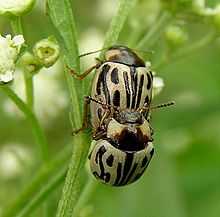Zygogramma
| Zygogramma | |
|---|---|
 | |
| Scientific classification | |
| Kingdom: | Animalia |
| Phylum: | Arthropoda |
| Class: | Insecta |
| Order: | Coleoptera |
| Family: | Chrysomelidae |
| Genus: | Zygogramma Chevrolat in Dejean, 1836 [1] |
Zygogramma is a large genus of leaf beetles in the subfamily Chrysomelinae, which include approximately 100 species. 13 species occur in north Mexico.[2]
Life cycle
The larvae feeds for 10 to 15 days on leaves and on maturity enters the soil and pupates below up to 15 cm depth. The beetles emerge after eight to 12 days and completes their life cycle in 27 to 32 days. Both the adults and larvae are capable of feeding on the parthenium leaves thus checking the plant growth and flower production.
Use as biocontrol
Parthenium hysterophorus is a weed that was imported into India along with the PL 480 Mexican wheat seeds in the 1950s. The weed has since grown into uncontrollable proportions, invading million of hectares of uncultivated wastelands, roadsides, railway tracks, etc. The fast-growing weed is a nuisance in public parks, residential colonies and orchards.
Moreover, it causes health hazards such as skin allergy, hay fever and asthma in human beings and is toxic to livestock. It squeezes grasslands and pastures, reducing the fodder supply. Scientists describe it as a "poisonous, allergic and aggressive weed posing a serious threat to human beings and livestock."
The presence of parthenium in cropped lands results in yield reduction up to 40 per cent. The pollen grains inhibit fruit set in tomato, brinjal, beans, etc. It is also responsible for bitter milk disease in livestock fed on grass mixed with parthenium.
Parthenium is a fast maturing plant with a deep tap roof that can grow to a height of 1.5 to 2 metres having branched leaves covered with fine hairs. It grows a large number of small white flowers and seeds of light weight that are easily dispersed to distant places causing allergy in human beings. Each plant can produce up to 10,000 seeds. It has the capacity to re-grow from the cut or broken parts. It has no natural enemies such as insects and diseases because of which it spreads rapidly in India.
After much research, Mexican beetles (Zygogramma bicolorata) was considered a "safe" biocontrol agent.
Adults defoliate the plant. Immature flowers are cut by the beetles in an effort to chew the soft tissues beneath the flowers. Completely defoliated plants start to show die-back symptoms and gradually get killed.
Species list
Here is some spcecies of the genus Zygogramma:
- Zygogramma arizonica Schaeffer, 1906
- Zygogramma conjuncta (Rogers, 1856)
- Zygogramma continua (J. L. LeConte, 1868)
- Zygogramma disrupta (Rogers, 1856)
- Zygogramma estriata Schaeffer, 1919
- Zygogramma exclamationis (Fabricius, 1798)
- Zygogramma heterothecae Linell, 1896
- Zygogramma malvae (Stål, 1859)
- Zygogramma opifera (Stål, 1860)
- Zygogramma piceicollis (Stål, 1859)
- Zygogramma signatipennis (Stål, 1859)
- Zygogramma suturalis (Fabricius, 1775)
- Zygogramma tortuosa (Rogers, 1856)
References
- ↑ "Zygogramma Chevrolat in Dejean, 1836". Integrated Taxonomic Information System. Retrieved February 3, 2011.
- ↑ BugGuide Genus Zygogramma